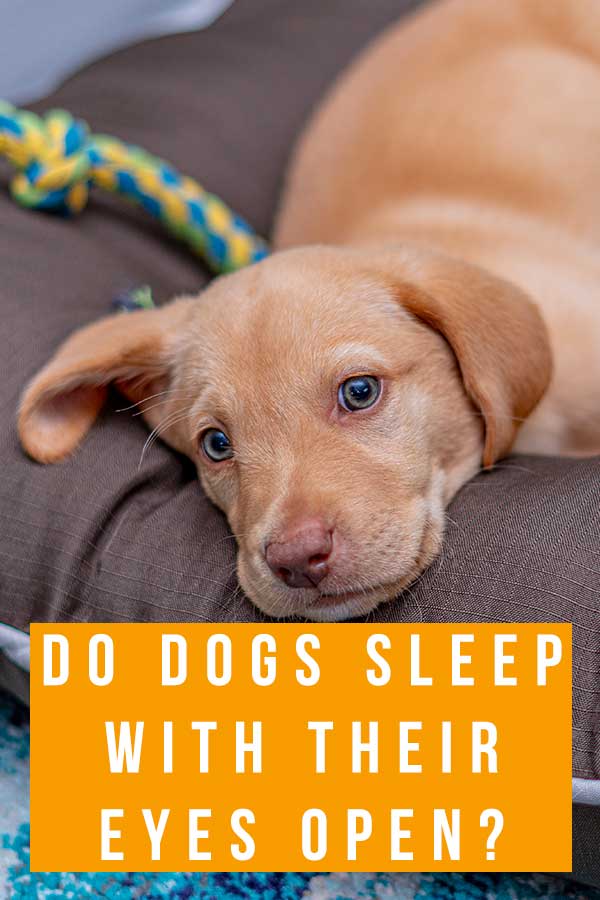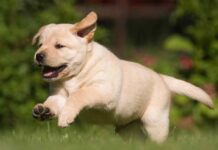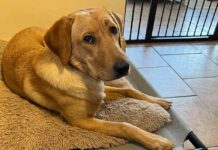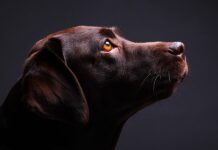Do dogs sleep with their eyes open, or are they only really asleep when their eyes are closed? Sarah Holloway explores the fascinating world of dog sleep!
The sight of a dog sleeping with eyes open, while apparently lost to the world, can be a bit unsettling! Although some dogs do sleep with one or both eyes open, this isn’t always the case. Today we’ll look at how to tell when your dog is asleep. We’ll also give you some signs to look out for that might show your dog is having health issues. And you’ll learn what’s going on when a fit and healthy dog sleeps with eyes open wide. It’s not as strange as you might think!
Contents
- Do dogs sleep with their eyes open?
- Benefits of sleeping with eyes open
- Is my dog asleep?
- Why do dogs sleep with their eyes open?
- Why is my dog sleeping with their eyes open?
- Medical conditions that make dogs sleep with eyes open
Do Dogs Sleep with Their Eyes Open – Or Is Something Else Going On?
Dogs do sometimes sleep with their eyes open. In fact, sleeping with one or both eyes partially open is not uncommon in dogs, and it’s usually harmless. But let’s find out if your dog is really asleep! We’ll share some fun facts, and give you some tips for if and when to get veterinary help for your friend. You can see from the video here of a dog sleeping with their eyes open what to look out for:
Why Do Dogs Sleep With Their Eyes Open? The Pros
Sleeping with their eyes open is a savvy survival strategy of lots of species. In some cases, it enables them to remain alert to predators and other dangers with part of their brain, while the other part rests. In other cases, it simply tricks predators into thinking they’re still alert! We don’t know for sure why dogs sleep with their eyes open, since they’re not the target of many predator species in the wild. But either of these advantages could be partly responsible.
Dog Third Eyelid Sleeping
If the thought of sleeping with unclosed lids is enough to make your eyes feel dry and itchy, let’s look at the structure of dogs’ eyes to see why that isn’t usually a problem. When dogs sleep with their eyes open a peep, it’s not usually their eye ball you can see immediately behind the lids.
Dogs have a third eyelid, called a nictitating membrane, which sits behind the outer eyelid. The nictitating membrane helps to clean and protect the surface of the eyeball by sweeping away dust and debris when the eye closes. When the eye opens, it retracts back into the inner corner of the eye.
Some animals, like birds, can control their nictitating membrane independently of their external eyelids. Dogs can’t do that – their nictitating membrane closes automatically when they shut their eyes, and reopens automatically too. But when their eyes are slightly open in their sleep, it’s usually the nictitating membrane in its closed positions you can see, rather than the surface of the eyeball.
The sight of a dog sleeping with their eyes open can be an unsettling one. Perhaps it seems a little unnatural. But did you know that around 1 in 5 people are thought to sleep with their eyes partly open too? In fact, the ability to sleep with their eyes only partially closed is a common trait of lots of species, including dogs.
Is My Dog Sleeping With Their Eyes Open?
If your pooch is crashed out in their favorite sleeping spot with their eyes ajar, it might not be immediately obvious whether they’re sleeping with their eyes open, or just awake. It isn’t silly to be unsure! As humans, we’re used to enjoying a long sleep cycle. There’s not much for us to worry about while we’re asleep, so we can safely become unresponsive to the rest of the world for hours at a time.
Dogs on the other hand only have a sleep cycle of only about 20 minutes, before they rouse again briefly, and drift back off. In the wild, this means they can keep regular tabs on their surroundings. In our homes it’s just an impossible habit to break – it’s hardwired into their brains! So if your pup has been snoozing for hours, but occasionally you catch him with his eyes open, one explanation is that he woke up briefly.
Why Is my dog sleeping with their eyes open?
If your dog is asleep with their eyes open, they may simply be one of those dogs that sleeps like that occasionally. There are times when a dog sleeping with eyes open is a cause for concern, we’ll look at those in a moment. But they are unusual. Chances are, your dog is just doing what comes naturally to them.
Do All Dogs Sleep With Their Eyes Open?
Lots of owners report their dogs sleeping with their eyes open a crack. But as far as we’re aware, no one has ever attempted to study which dogs do it the most often. So we don’t really know if it’s linked to size, age or sex, for example.
But anecdotally, some people do think they witness it more often in dogs with very long or very flat faces. In fact, vets are worried that some brachycephalic dogs who have been specifically bred for over-exaggerated flat faces are losing the ability to fully close their eyes at all. This is because the shape of their skull forces their eyes to protrude so far from their socket that the lids can’t comfortably close over them.
It is one example of when dogs sleeping with their eyes open stops being benign, and starts being a cause for concern. Let’s look at some others next.

When To Be Concerned About A Dog Sleeping With Their Eyes Open
Dogs who have their eyes partly open during normal sleep are rarely anything to worry about – except for the unfortunate flat faced breeds. The occasions to be concerned are when:
- Dogs have their eyes open because their sleep is abnormal. This may happen if they are narcoleptic.
- It appears that a dog is sleeping with their eyes open, but in fact they’re not asleep at all. This may happen if they’re epileptic.
In these situations, the dog is no longer sleeping normally with their eyes a little open – something else is happening and their eyes are open. Let’s look at both of those conditions in a bit more detail.
Narcolepsy
Narcolepsy is a neurological disorder which causes dogs to fall asleep suddenly, at inappropriate moments, such as during exercise. It’s frequently an inherited disorder, linked to a genetic fault in the brain pathways which control sleep. The hereditary form is most commonly seen in Doberman Pinschers, but it has also been documented in Poodles, Dachshunds and Labradors.
When dogs experience a narcoleptic episode, their brain flicks very suddenly into sleep mode. And shortly after, flicks back into wake mode. During the episode, they collapse to the ground, and they might lie there completely still, or they might twitch and move about as if entering a dream sequence. Dogs in a narcoleptic episode quite often have their eyes partly open. In some cases, their eyes are still sending some information to the brain as well.
Epilepsy
Dogs with epilepsy suffer from recurring seizures. We often picture seizures as rather dramatic events, with lots of convulsive muscle movements. That type of seizure is called a grand mal seizure. But epileptic dogs can also have petit mal seizures, also known as absent seizures.
During absent seizures, dogs might tremble, drool, or lie on the floor with their eyes unfocused and vacant. Since they’re unresponsive to your voice or touch while the seizure is going on, it gives the impression of being asleep with their eyes open.
When To Let Sleeping Dogs Lie, And When To Call A Vet
Since sleeping with their eyes open is fairly normal, it doesn’t require veterinary attention. But you can ask about anything you like at your Lab’s next check up! These are some thing you should definitely raise with your vet:
- If your dog regularly sleeps with their eyes open, and their eyes seem dry, itchy, excessively watery, inflamed, or sore.
- If your dog falls asleep very suddenly at unexpected moments, such as during exercise.
- Or if you can’t gently rouse them from sleeping with their eyes open by calling their name softly from a few feet away.
Never try to rouse a dog sleeping with their eyes open by touching them or startling them. Dogs can be disoriented in the split second after waking up, and mistake these for acts of aggression.
Does Your Labrador Sleep With Their Eyes Open?
Why not tell us about them over on our forum?
References and Resources
Adams & Johnson, Sleep-wake cycles and other night-time behaviors of the domestic dog, Applied Animal Behavior Science, 2003.
Douglass, Animals’ extraordinary sleeping strategies, BBC Earth, 2015.
Hunter & Buzhardt, Narcolepsy in Dogs, VCA Animal Hospitals, accessed June 2020.
Plummer, Addressing Brachycephalic Ocular Syndrome in the Dog, Today’s Veterinary Practice, 2015.
Ward & Gollakner, Seizures in Dogs, VCA Animal Hospitals, accessed June 2020.
The Labrador Site Founder
Pippa Mattinson is the best selling author of The Happy Puppy Handbook, the Labrador Handbook, Choosing The Perfect Puppy, and Total Recall.
She is also the founder of the Gundog Trust and the Dogsnet Online Training Program
Pippa's online training courses were launched in 2019 and you can find the latest course dates on the Dogsnet website


















